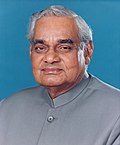| Portrait | Minister
(Birth-Death)
Constituency | Term of office | Political party | Ministry | Prime Minister |
|---|
| From | To | Period |
|---|
| Minister of Environment and Forests |
|---|
|  | Rajiv Gandhi
(1944–1991)
MP for Amethi
(Prime Minister) | 31 December 1984 | 22 October 1986 | 1 year, 295 days | Indian National Congress | Rajiv II | | Rajiv Gandhi |
|  | Bhajan Lal
(1930–2011)
Rajya Sabha MP for Haryana | 22 October 1986 | 14 February 1988 | 1 year, 115 days |
|  | Ziaur Rahman Ansari
(1925–1992)
MP for Unnao
(Minister of State, I/C until 25 Jun 1988) | 14 February 1988 | 2 December 1989 | 1 year, 291 days |
|  | Vishwanath Pratap Singh
(1931–2008)
MP for Fatehpur
(Prime Minister) | 2 December 1989 | 23 April 1990 | 142 days | Janata Dal | Vishwanath | | Vishwanath Pratap Singh |
|  | Nilamani Routray
(1920–2004)
MP for Puri | 23 April
1990 | 10 November
1990 | 201 days |
|  | Maneka Gandhi
(born 1956)
MP for Pilibhit
(Minister of State, I/C) | 10 November 1990 | 21 June 1991 | 223 days | Samajwadi Janata Party (Rashtriya) | Chandra Shekhar | | Chandra Shekhar |
|  | Kamal Nath
(born 1946)
MP for Chhindwara
(Minister of State, I/C) | 21 June 1991 | 15 September 1995 | 4 years, 86 days | Indian National Congress | Rao | | P. V. Narasimha Rao |
|  | Rajesh Pilot
(1945–2000)
MP for Dausa
(Minister of State, I/C) | 15 September 1995 | 16 May 1996 | 244 days |
|  | Atal Bihari Vajpayee
(1924–2018)
MP for Lucknow
(Prime Minister) | 16 May 1996 | 1 June 1996 | 16 days | Bharatiya Janata Party | Vajpayee I | | Atal Bihari Vajpayee |
|  | H. D. Deve Gowda
(born 1933)
Unelected
(Prime Minister) | 1 June 1996 | 29 June 1996 | 28 days | Janata Dal | Deve Gowda | | H. D. Deve Gowda |
|  | Jai Narain Prasad Nishad
(1930–2018)
MP for Muzaffarpur
(Minister of State, I/C) | 29 June 1996 | 21 February 1997 | 237 days |
|  | Saifuddin Soz
(born 1937)
Rajya Sabha MP for Jammu and Kashmir | 21 February 1997 | 21 April 1997 | 1 year, 26 days | Jammu and Kashmir National Conference |
| 21 April 1997 | 19 March 1998 | Gujral | | Inder Kumar Gujral |
|  | Suresh Prabhu
(born 1953)
MP for Rajapur | 19 March 1998 | 13 October 1999 | 1 year, 208 days | Shiv Sena | Vajpayee II | | Atal Bihari Vajpayee |
|  | T. R. Baalu
(born 1941)
MP for Chennai South | 13 October 1999 | 21 December 2003 | 4 years, 69 days | Dravida Munnetra Kazhagam | Vajpayee III |
|  | Atal Bihari Vajpayee
(1924–2018)
MP for Lucknow
(Prime Minister) | 21 December 2003 | 9 January 2004 | 19 days | Bharatiya Janata Party |
|  | Ramesh Bais
(born 1947)
MP for Raipur
(Minister of State, I/C) | 9 January 2004 | 22 May 2004 | 134 days |
|  | A. Raja
(born 1963)
MP for Perambalur | 23 May 2004 | 15 May 2007 | 2 years, 357 days | Dravida Munnetra Kazhagam | Manmohan I | | Manmohan Singh |
|  | Manmohan Singh
(1932–2024)
Rajya Sabha MP for Assam
(Prime Minister) | 15 May 2007 | 22 May 2009 | 2 years, 7 days | Indian National Congress |
|  | Jairam Ramesh
(born 1954)
Rajya Sabha MP for Andhra Pradesh
(Minister of State, I/C) | 22 May 2009 | 12 July 2011 | 2 years, 51 days | Manmohan II |
|  | Jayanthi Natarajan
(born 1954)
Rajya Sabha MP for Tamil Nadu
(Minister of State, I/C) | 12 July 2011 | 21 December 2013 | 2 years, 162 days |
|  | Veerappa Moily
(born 1940)
MP for Chikballapur | 21 December 2013 | 26 May 2014 | 156 days |
| Minister of Environment, Forest and Climate Change |
|---|
|  | Prakash Javadekar
(born 1951)
Rajya Sabha MP for Madhya Pradesh
(Minister of State, I/C) | 27 May 2014 | 5 July 2016 | 2 years, 39 days | Bharatiya Janata Party | Modi I | | Narendra Modi |
|  | Anil Madhav Dave
(1956–2017)
Rajya Sabha MP for Madhya Pradesh
(Minister of State, I/C) | 5 July 2016 | 18 May 2017
(died in office) | 317 days |
|  | Harsh Vardhan
(born 1954)
MP for Chandni Chowk | 18 May 2017 | 30 May 2019 | 2 years, 12 days |
|  | Prakash Javadekar
(born 1951)
Rajya Sabha MP for Maharashtra | 31 May 2019 | 7 July 2021 | 2 years, 37 days | Modi II |
|  | Bhupender Yadav
(born 1969)
Rajya Sabha MP for Rajasthan, till 2024
MP for Alwar, from 2024 | 7 July 2021 | 9 June 2024 | 4 years, 147 days |
| 10 June 2024 | Incumbent | Modi III |
|



































